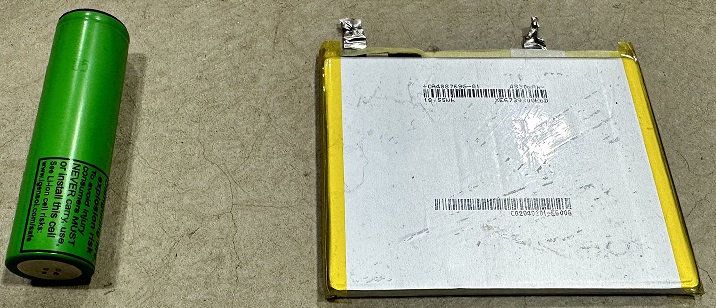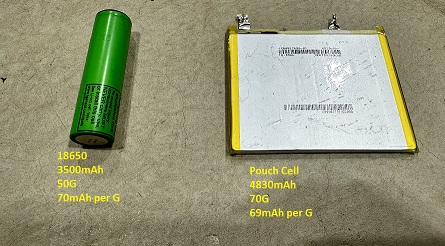
What is the Difference Between 18650 and Pouch Cells?
Table of Contents
18650 cells are lithium-ion battery chemistry rolled up and inserted into a hard metal can and pouch cells are that same chemistry in stacked sheets.
18650s have their battery chemistry wound up in a very tight spiral called a jelly roll with very little distance between each layer. Pouch cells, however, are not compressed into a roll and they are sheets laying on top of each other, with the space between those sheets being a little wider. There are also much fewer layers in a pouch cell compared to a 18650.
Pouch Cells And 18650s Structure and Design Differences
18650 cells are cylindrical format compared to pouch cells format which is in the shape of squares and rectangles.
18650 Cells:
18650 cells are cylindrical in shape and are composed of lithium-ion battery chemistry rolled up and inserted into a hard metal can. The battery chemistry is wound up in a tight spiral, known as a jelly roll, with very little distance between each layer. Small tab electrodes are placed at the end of the sheets of battery chemistry to extract current.
Pouch Cells:
Pouch cells, on the other hand, feature the same lithium-ion chemistry but are housed in a flexible pouch rather than a hard metal can. Unlike 18650 cells, pouch cells are not compressed into a roll; instead, they consist of sheets laying on top of each other, with a wider space between the sheets. The design allows for more room for the electrodes to fan out, supporting high current flow.
Are 18650s More Energy Dense Than Pouch Cells?
18650 cells have a higher energy density, meaning they can store more energy in a given volume. This makes them suitable for applications that require long-lasting power. In fact, most DIY battery packs use 18650 cells for this exact reason. In contrast, pouch cells have a lower energy density, resulting in an overall lower-capacity battery given the same space.
The cylindrical format of 18650 cells lowers their packing efficiency due to the void space between cells. Pouch pouch cells have a higher packing efficiency, especially in applications that require odd or thin-shaped batteries, and this helps make up for their lower energy density in some applications.
Can Pouch Cells Handle More Current Than 18650s?
Pouch cells excel in applications that require extremely high current carrying capacity. They can support currents on the order of a hundred C or more, making them ideal for high-power applications. In contrast, the current carrying capability of 18650 cells is limited by the small tab electrodes.
Pouch cells have a higher power density, which refers to the rate at which energy can be delivered. This makes them suitable for applications that demand rapid energy discharge. 18650 cells, on the other hand, have a lower power density.
Pouch Cells vs 18650 Internal Resistance
The physical design differences between pouch cells and 18650 cells directly impact their internal resistance. A lower internal resistance allows for more current to flow, whereas a higher internal resistance restricts the current flow and will generate more heat per amp. The jelly roll configuration of 18650 cells is a tight spiral with small tab electrodes used in these cells. This is the main contributing factor to 18650s having higher resistance than pouch cells.
Pouch cells are able to have a lower internal resistance due to their physical design. With the battery chemistry arranged in sheets that have wider electrodes that are larger and more spread out, enabling lower resistance and higher current flow.



